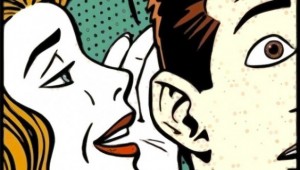Without hesitation, Fun Home is clearly literature, and a brilliant example of it. Alison Bechdel does a phenomenal job developing her characters and their relationships with each other through the use of words, leaving the setting to be described through the use of visuals. Although a visual depiction is present, her writing is a necessary and effective tool in telling her story. Various definitions of the word “Literature” that I found online defined them differently. While one definition described it as “written works,” another said that literature is simply “books and writings.” Alison includes visuals in her memoir, but only as supplementary tools to help her achieve the best representation of her memory. An example of this would be her house. She could have used words to describe all of the rooms throughout the house, carefully describing each item in the house that was interesting, but instead chose to show drawings of the house and her presence in the house. Doing so allows her to let readers interpret the house and how she reacts to different parts of it by simply analyzing each picture, and how the narration above or within it correlates with the scene on that page. Continue reading
Author Archives: Devon McMillan
Are You Taking Notes?
Imagine you are a writer, and at the very beginning of starting a creative nonfiction story. You’re sitting at a desk. Only a desk-lamp illuminates the desktop, and you are surrounded by darkness. All that matters is your clear mind, the pad of lined notebook paper on the desk and the #2 pencil sitting beside it. Before any graphite touches the paper, you think to yourself, “Why am I going to write this? “What is the main theme of the story?” Once writers find those answers, it is in their best interest to tell the story with the best accuracy they can, while most importantly making the story as intriguing as possible. Many times in creative nonfiction, writers will alter the truth, in order to make the story flow better and keep the reader engaged, which will help better project the main theme. When writers do this, are they straying from the truthful nature of nonfiction? Or are the white lies and alterations of the truth only included to help the author establish and clearly project their main theme? Continue reading
White Lies
Everyone tell lies. In many cases, lies, whether severe or small, are used to deceive a person into feeling a certain way. Sometimes, lies are told to benefit not the liar, but the person or people that they are lying to. Other times, lies are told to benefit the liar, like that time in 10th grade when you came home past curfew and your excuse to your parents was that you, “forgot how late it was.”
Now to focus on a liar who entraps her readers by establishing a theme challenging our minds to see what is truth, and what is fiction. Lauren Slater is the main attraction in her “factual” memoir, where she gives us a first row seat to all of her most intimate memories as she grows from a helpless child, to a young woman. Continue reading
I Love You Too
Have you ever looked into someone’s eyes, and for a moment, the rest of the world around you fades into nothingness? For that one moment, you feel entrap ped by an unexplainable feeling. This short but deep infatuation is what so many strive to share with one they can call their own. Many don’t know what love is until they see it. And when they see it, they know. Continue reading
ped by an unexplainable feeling. This short but deep infatuation is what so many strive to share with one they can call their own. Many don’t know what love is until they see it. And when they see it, they know. Continue reading
Are You Listening?
Have you ever been sitting peacefully on your bed in your room, when your mother or father enters unexpectedly with a demoralizing speech at hand about how you failed to do a simple chore like taking out the trash or cleaning the cat’s litter-box? If you do, try to remember their tone of voice. It wasn’t pleasant, was it? In cases such as this, an authority figure uses inflections in his or her vo ice in order to inspire feelings of negativity, guilt, and sorrow in their audience (you). Although in this case the use of the voice is being used to carry out a punishment, it is used in an unbelievable variety, everywhere you look.
ice in order to inspire feelings of negativity, guilt, and sorrow in their audience (you). Although in this case the use of the voice is being used to carry out a punishment, it is used in an unbelievable variety, everywhere you look.
When a movie producer scouts talent for a movie, they study the ability of actors and actresses to use their facial expressions, body expressions, and voices. Just like parts of the body, the voice is an expressive tool used to display an unlimited amount of emotions and feelings. This is something that Sarah Koenig uses to her advantage in Serial. Koenig’s inclusion of various characters and their voices allows her listeners to hear the emotions of her subjects in the truest nature. The audience of Serial needs little imagination in order to comprehend and enjoy the podcast fully. But does Sarah do this in order to establish a story that’s unique, or is it just her intention to project her own feelings to the story? Continue reading
Is Truth the Key to Creativity?

“…the secret point of money and power in America is neither the things that money can buy nor power for power’s sake (Americans are uneasy with their possessions, guilty about power, all of which is difficult for Europeans to perceive because they are themselves so truly materialistic, so versed in the uses of power), but absolute personal freedom, mobility, privacy. Is is the instinct which drove America to the Pacific, all through the nineteenth century, the desire to be able to find a restaurant open in case you want a sandwich, to be a free agent, live by one’s own rules.” – Joan Didion
Many writers around the world are faced with a pressing challenge. Creativity. It is a writers main interest to include as much creativity as they possibly can in their stories in the hope that their readers become immersed in the story they tell. But creativity does not come easily to all. Many struggle to find the right way to tell a story in an exciting and innovative fashion. What is the foundation in which creativity is formed? I believe that it is truth. Continue reading